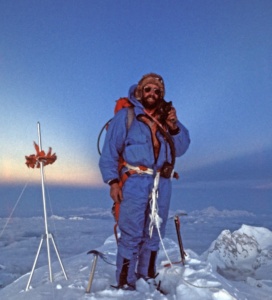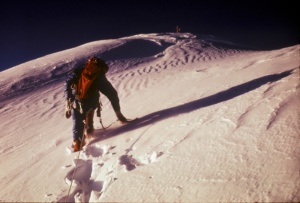Doug Scott comes from the generation of climbers for whom, the journey was more important than the destination. Over the years, his adventures – and misadventures – took him up several big walls that include Everest and The Ogre.

First published:
https://www.firstpost.com/living/aint-no-mountain-high-enough-legendary-mountaineer-doug-scott-on-chasing-peaks-3327364.html
Ain’t no mountain high enough for Scott
Before the 90th year celebration of The Himalayan Club, the Englishman talks about his trials and tribulations up some of the biggest mountains of the world.
A mountaineer, in the true sense of the word, thrives on the challenges of the unknown. It summarises what Doug Scott has chased all his life, since he started climbing at 13.
At the annual seminar of The Himalayan Club as part of their 90th year celebration in February, the legendary mountaineer, now 75, summed up the inspiration behind his wanderings in some of the most remote mountains of the world.
“The interesting thing is to pioneer your own way. Once it’s been done, it’s been done. You know it’s possible and the uncertainties are not so great. To go where no one has been means it’s always going to be interesting – that’s what makes for a good adventure,” Scott said.
It was this mantra that Scott followed all through his climbing days. Chasing puzzles posed by technical routes up rock faces and the journey en route was what motivated him, rather than the glory that came alongside summiting mountains. Then, it mattered little that Everest (8,850m) had been climbed multiple times by the time he got there in 1972. What drove Scott towards the mountain was the daunting south-west face, which was considered to be the last few challenges on Everest, and had denied three previous expeditions. The team led by Sir Chris Bonington too returned without seeing the summit.
“We had turned back after reaching 27,800 feet (about 8,473m) in 1972. It was too late, the winds were horrendous and there was no possibility of climbing the rock band (vertical cliffs on the mountain that needs technical climbing skills) in that weather,” he said.
Three years later, Scott was back alongside his partner, Dougal Haston, on another Bonington-led expedition.
“When we came back in the autumn of 1975, we had six on the team who had been there before, including three who had been there twice. So there was a lot of experience,” he said.
The stage was set for a summit attempt after Tut Braithwaite and Nick Estcourt had paved the way through the tricky rock band. At 6.30 pm on 24 September, Scott and Haston became the first Brits to reach on top of Everest. As Scott took multiple photos and stood in awe watching ‘the sun filter down behind layers of cloud, occasionally breaking through in an explosion of light’, he soon realised that they had only half an hour left before it got dark.
By the time they reached the col of South Summit, it was impossible to move ahead. So, the duo settled down for the night in a snow cave at 28,700 feet (8,748m) — the highest bivouac on the mountain. To make matters worse, they had no sleeping bags, and soon ran out of oxygen and fuel for the stove.
“Our focus was to stay awake that night and not drift away. We also didn’t want to lose any fingers and toes, and I remember putting my feet under Dougal’s armpits to keep them warm,” he said.
“We began to wander in our thoughts. The idea was to stay awake for those nine hours until there was light,” he recalled.
Luckily for them, they made it off the mountain safe, even as they lost another teammate, Mick Burke, during the climb. But then on, Scott knew that lightweight, alpine-style expeditions was what appealed to him the most.
“It’s the case of less is more — less gear, more adventure; less people, more adventure,” he said of his philosophy.

A couple of years later though, things got quite rough during another first ascent in the Karakorams. Scott, alongside five other climbers, flew into Kabul and hitchhiked to Pakistan via the Khyber Pass. The agenda was to climb the pillar of Baintha Brakk (7,285m), popularly known as The Ogre. What Scott and Bonington wanted to attempt was the south face of the mountain — a near-vertical face of about 1000 metres.
Having established camp at 7000 metres, the two had a go up the final tower which required superior rock climbing skills and at that altitude. After getting to the top on July 13 as the sun set in the distance, Scott led the abseil down. However, in one patch, he smashed into the rock face and soon realised that he was left with broken legs at the ankle and on a rope, high up on the mountain. It now became a fight for survival and brought out the best in him.
“I never thought of not making it back — I’m from Nottingham, we don’t die easily,” he smiled.
For five stormy days, Scott and Bonington, who later broke his ribs in another accident, went without food. At one camp, they survived the night on tea made from some tea bags that they had earlier discarded on their way up and a packet of sugar cubes they found in the tent. At a lower camp, they rummaged through a trash bag and made a meal of the discarded rice and cigarette ash at the bottom.
“The idea was to take it one feature at a time. So I would find a rock in the distance and crawl to it. Once there, I would be quite pleased with the effort and move on to the next one,” he said.
After descending all the way to the foot of the mountain, Scott had to crawl his way to Base Camp and was left with layers of shredded pants and bruised knees. It had taken the party seven days to make it there. A wait of another five days and a three-day carry by porters on a make-shift stretcher finally saw Scott on a helicopter, which almost came to a crashing halt after it suffered engine problems towards the end of the journey.
“It was alright,” Scott said nonchalantly.
“I was operated on 4 August back home and the next spring (1978), I was on Mount Waddington (4,019m) in Canada,” he added.
The same year, he made unsuccessful attempts on K2 and Nuptse, but in 1979, made a bold attempt on Kanchenjunga — the third highest mountain in the world at 8,586 metres — via the north ridge. This was only the third, successful attempt on the mountain and the first without oxygen.
“It was a huge adventure, just the four of us. The outcome was uncertain right until the end after three months on the mountain. We had Sherpa support only till the North Col. There was no bulky gear, no radios or walkie talkies, and no satellite phones,” he said.
These days, the rules of mountaineering — and the concept on the whole — has changed for a majority of people who attempt the high mountains, which irks Scott to an extent.
“In those days, we used to tell our wife and children – see you, in two or three months, maybe. Of course, you can write to me but there’s not guarantee you’ll get letters. I mean, imagine being high up in those serene settings and the wife rings in – the kid broke his leg, the toilet is blocked. I mean, who wants to know about that?” he said.
“Then, there are these high-altitude tourists who are all guided by their Sherpas. They hardly need to make any judgements, so you can’t call them climbers in the usual sense. With the sheer numbers on Everest these days, it’s impossible to enjoy the mountain. Even prostitutes have moved into the Base Camp on the north side,” he said.
Scott may come from the old school of climbing, yet his words couldn’t be more true given how mountaineering is being chased today. He believes climbing remains as pure as when the first climb was attempted, and it’s only a few killjoys out there who need to be set right.
“We’ve sent across a few proposals to the Nepal authorities. Anyone who applies for a permit to climb Everest must have climbed at least two other 6,500-7,000 metre peaks in Nepal. It will not only reduce the numbers on Everest, but will also increase high altitude tourism in other parts,” he said.
For mountaineering to retain its old world charm, Scott quotes Bob Dylan:
‘An’ though the rules of the road have been lodged
It’s only people’s games that you got to dodge.’